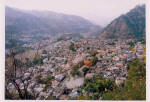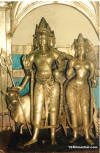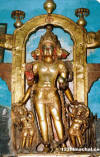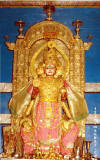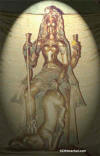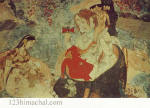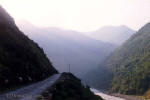|
Chamba
Nestled on the bank of the river
Ravi, Chamba town complete 1000 years of its existence. The town stands on
a plateau on the right bank of the Ravi river valley between Dhauladhar
and Zanskar ranges south of the inner Himalayas. This town was founded by
Raja Sahil Varman in the beginning of 10th Century. In the genealogical
rolls of the Chamba Rajas, a reference occurs of place, which was adorned
with highly fragrant Champaka trees and guarded by Goddess Champavati.
The temple was built
by Sahil Varman in the honour of his daughter Champavati who is worshipped
as a goddess in Chamba. This glorious journey of one thousand years is a
rich repository a highly civilized, cultured and developed society which
existed in the lap of Himalayas. The unique architect of houses and
temples, splendid wood and metal craft, world fame Chamba Rumal and
Chappal and of course the exquisite pahari paintings are some salient
features of this one thousand years young town. The Chamba town has a
number of temples, Palaces and stylised buildings. The striking objects of
interest are the old temples which exhibit architectural beauty of design
and execution. Laxmi Narayana Temple, which is the main temple of Chamba
town, was built by Sahil Varman in the 10th century AD. There are several
other temples within the
complex.
The temple of
Radha Krishna, Shiva Temple of Chandergupta and Gauri Shankar Temple are
among these. The ancient temple of Vajreshwari is believed to be 1000
years old and is dedicated to Devi Vajreshwari-Goddess of lightning. The
Sui Mata temple can be divided into three parts which can physically
spread apart. The Hari Rai temple is dedicated to Lord Vishnu and dates
back to 11th century. A yet another place of interest in Chamba town is
the Bhuri Singh Museum at Chamba which came into existence on 14th
September, 1908. It is named after Raja Bhuri Singh who ruled Chamba from
1904 to 1919. Bhuri Singh donated his family collection of paintings to
the museum. The embroidered Chamba-Rumals are related in style since their
drawings were made by pahari painters though the embroidery was done by
the household
ladies.
Reference of Chamba town would be incomplete without the majestic Chaugan.
It is the heart and hub centre of all activities in Chamba. Tradition is
silent as to its use as a polo ground and the name is etymologically
distinct from Chaugan, the Persian name of Polo, being of Sanskrit origin
and meaning 'four-sided'. Initially the five Chaugan were a single patch
of meadow. To mark the completion of 1000 years of this town, the
Government of Himachal Pradesh is celebrating the millennium of this town
from 14th to 20th April, 2006 in a most befitting way. The celebrations
would provide the people the opportunity to have a first hand knowledge of
the rich cultural and historical past of the Chamba town.
More Details >
TEMPLES OF CHAMBA & BHARMOUR
The mountain ranges running
through Chamba from south-east to north-west and forming the watersheds of
the great rivers are,-the Outer Himalaya or Dhaula-Dhar, separating the
Bias from the Ravi ; the Mid-Himalaya or Pangi Range-the Pir Panjal of
geologists-separating the Ravi from the Chinab ; and the Main Himalaya
closing in the State to the north and separating the Chinab from the
Indus.
Chamba has had the rare good
fortune to escape the succe'ssive waves of Muhammadan invasion, which
swept away all monuments of old Indian civilization on the plains. The
result is that its ancient remains are more abundant and better preserved
than in any other part of the Panjab.Sir Alexander Cunningham was the
first to draw attention, in 1839, to the ancient remains of Chamba, but it
was only in more recent years that the whole wealth of antiquarian and
especially epigraphical material has come to light. The inscriptions are
found all over the State and are remarkable alike for their number and
their variety. Excluding the last two centuries, no fewer than l30
inscriptions have been collected, of which 50 are of the pre-Muhammadan
and 80 of the Muhammadan period. The oldest inscriptions are in the Gupta
character, of the seventh century.
The Chamba District is
situated between north latitude 32° 11΄ 30″ and 33° 13΄ 6″ and east
longitude 75°49 and 77° 3΄ 30″, with an estimated area of 6528 square
Kilometers and is surrounded on all sides by lofty hill ranges. The
territory is wholly mountainous with altitude ranging from 2,000 to 21,000
feet.
Colours of
Himachal Photo Gallery
HOW TO GET THERE
:
1. Rail : Connected with
Pathankot (80 km) which in turns, is connected with Jammu, Delhi, Culcutta
& Mumbai.
2. Road : Shimla, Delhi,
Manali Dharamshala and Jammu.
3. Air : Gaggal airport 10
km, from Kangra town on Pathankot-Manali highway, Vayudoot operates from
Delhi, Shimla and Chandigarh.
Places of Tourist
Interest
Lakshminarayan
Temple
The Lakshminarayan temple
complex is very important from the archaeological point of view. This
temple was constructed during the 10th century at the time of king Sahil
Verma. In this complex, there are five other main temples namely Radha
Krishna, Chandra Sekhara Mahadev, Gaurishankara, Tryambakeshwara and Laxmi
Damodara. They are artistically decorated and all have been built in the
Nagar style. There are also some other small temples in the complex, there
is a galaxy of temples in Chamba which are dedicated to Harirai,
Champavati, Bansigopal, Ram Chandra, Bajreshwari, Chamunda, Narisingh and
Yogi Charpat Nath etc.
|
Chaurasi
Temples of Bharmaur |
|
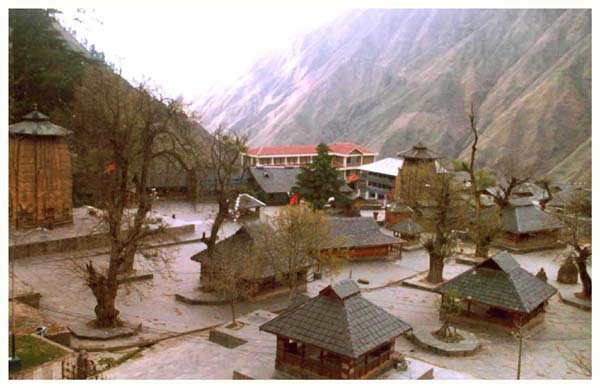
|
|
IMAGE
by P r Bali |
The
main temples of Lakshmi Devi, Ganesh, Manimahesh and Narsing in Bharmaur
are known as the Chaurasi temples. According to a legend, Chaurasi yogis
visited Bharmaur during the reign of king Sahil Verma. Pleased with the
King's humility and hospitality, the yogis blessed the king
with
ten sons and a daughter Champawati. The temples
dating back to the 9th century, are one of the most important early Hindu
temples in the Chamba valley. The distance of 65
km from Chamba to Bharmaur is covered
by hired vehicles Buses ply only during yatra days in
September.
THE EARLY
WOODEN TEMPLES BHARMOUR
S M Sethi
 The successive waves
of Mohammdan invasions in the past which had rich have of ancient
monuments on the plains were swept off the snow clad mountain lorries of
Chamba one of the oldest native states of Indian consequently Chamba
proved luckier than most of its sister states of the east while Punjabis
not abandoning even a fraction of its rich culture of wealth to foreign
power. The temples erected by the rajas of Chamba more than thousand years
ago continue to remain under worship until the present times and the
temple land grants exacted by them on the copper plates enjoy validity
under law even today of special mention are the early wooden temples of
Bharmour ( Chamba) . Constructed of heavy and fragrant deodar wood;
though easily perishable by nature ; the temples have with stood the
vagaries of time and now represent the sole and earliest extant specimen
of stone earning techniques as applied to 7th century
A.D. The successive waves
of Mohammdan invasions in the past which had rich have of ancient
monuments on the plains were swept off the snow clad mountain lorries of
Chamba one of the oldest native states of Indian consequently Chamba
proved luckier than most of its sister states of the east while Punjabis
not abandoning even a fraction of its rich culture of wealth to foreign
power. The temples erected by the rajas of Chamba more than thousand years
ago continue to remain under worship until the present times and the
temple land grants exacted by them on the copper plates enjoy validity
under law even today of special mention are the early wooden temples of
Bharmour ( Chamba) . Constructed of heavy and fragrant deodar wood;
though easily perishable by nature ; the temples have with stood the
vagaries of time and now represent the sole and earliest extant specimen
of stone earning techniques as applied to 7th century
A.D.
The wooden temples are located in the heart of the village compound known
as Chaurasi. At this place Raja Sahila Verman (A .D .920) the founder of
Chamba had spent the evening of his life in the company of saint Charpat
Nath and other eighty four Siddhas. These eighty four siddhas perform
austerities and undertook tapes and were custodian to Samadhi lingas which
can still he pointed out in the small green and in which also stand almost
all the temples of Bharmour and which for this reason is known as
CHAURASI.
Right at the centre Chaurasi like a jewel in the crown stands the
monumental temple of `Mani Mahesh' in whose sanctum `garbha grihya' a huge
monolithic ` Shiva Linga' is enshrined. Though the temple is believed to
have been commissioned by Raja Sahila Verman in the 10th cent. A. D. the
small entrance door of the shrine indicates the early existence of Linga
around which was built later the present as one lithic stone structure. At
a little distance away facing the shrine is the brass image of Nandi bull
who in conformity with the ancient texts stand in all tours indicating the
solidity and stability of dharma ( Varsbh hi bhagwan dharma) and is intent
on gazing at the splendor of his master Devavi Kshana tatpara). and is the
one with fatty ( pin kapol kaya ) script of 7th century record the name of
the patron King Meru Verman and the mats craft man Gugga. The insription
goes on to state that the raja erected the temple in the likeness of mount
Meru OM PRASADAM MERU SADRISHAM and equipped it with various mandopao
Rangshallas and Chaitya dormers of special mention in the compound of
Chaurasi, is the people of Lakshma Devi which gives the appearance of a
simple wooden hut from a distance it is the sole temple in Bharmour which
reveals several features of ancient wooden shrines in its exquisitely
carved massive entrance door way and rich ornamentation of the interior in
wood. While the mesons all over India had already resorted to dressed
store as building material in this remote and secluded valley the
craftsmen still dreamt their dreams in wood producing charming and lasting
effect. Once in side the viewer is heed transfixed by the Devi
looking straight at him ( Sam ) with serene and detached expression
(samya) and when the viewers eyes travel down and notices the four
armed Goddess standing in warrior like posture (pratya-alidha) with
her right foot planted firmly on the head of the killed buffalo demon
while with her left hand she catches the buffalo's tail and lift her whole
body vertically . Her standing posture corresponds exactly to the
description of Devi Mahatamya.
EVAMUKVA
SAMPUTPAYA SARUDHA TAMA MAHASURAM PANEN KRAMYA KANTHE CASUHENAITAM
AVADAYAT
AVADAYAT
The
physiognomy of the Devi confirms to the eanous of ideal beauty as
prescribed in the ancient texts her face is broad like a full moon the
nose has the high delicately arched bridge like a parrots bill
her lips are curved like the `sesamum flowers' her brows are arched like
fish or willow leaf. Another brass image of Ganesha is cast by the same
pair of the artist and the donor Ganesha wears a Gandhara crown and holds
his usual attributes. Only his trunk is turned towards the right
instead of the usual left. The missing leg of the image allude to some
past invasion which has taken its toll .
The visit to Chaurasi will be deemed incomplete without paying homage to
the deity Narsimha whose modest shrine finds place in one corner of
Chaurasi. The temple had suffered a serious damage in the earth quake of
1905. In this temple of Narsimha the life size brass image shown seated on
a high pedestal in European fashion. The awe inspiring deity true to his
attributes has rolling eyes, flaming mouth and seems quite ready to pounce
upon and tear apart the belly of Hariva Kashyp whose image finds no
depiction in metal but is left to the imagination of the
viewers.
Chattrari
temple :
Though
mostly rebuilt, this temple dedicated to Shakti, houses a sanctuary and a
colonnade that preserve early examples of carved wood work. The sculptures
suggest post-Gupta influence from central India. Cedar columns are
fashioned with pot and foliage motifs . Enshrined within the sanctuary is
a large 8th century brass image of Shakti; the goddess is richly adorned
with jewels and a crown. There are also attendant figurines and a brass
image of Shiva
.
MANI
MAHESH LAKE (4170 m.) :
This sacred lake is situated
at the base of Mani Mahesh Kailash Peak (5656m.) and is one of the highest
lakes in Himachal Pradesh . It is a place of great pilgrimage and
thousands of devotees pay their homage and take a dip here especially in
the month of August-September when a `Chhari Yatra' is held. The Mani
Mahesh shikara style temple is
one of the most ancient and beautiful shrines in Himachal
Pradesh.
Chamba
Rumal
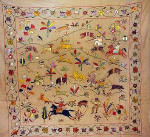 Chamba
embroidery of Himachal Pradesh manifests the skilled use of double satin
stitch on the body and the stem stitch on the outlines in the polycoloured
silk thread. Popularly known as the Chamba rumals, this embroidery was
practiced earlier in the Chamba, Bilaspur, Nurpur, Kangra, Basholi regions
of Himachal Pradesh. With the concentration of embroiderers around Chamba,
the designs depict the narratives of the Krishna legends and other themes
in double satin stitch. This gives the unique mirror image patterns on
both the sides. The rumals are not only noted for their rich aesthetic
effect but also for significance of the subject matter. Chamba
embroidery of Himachal Pradesh manifests the skilled use of double satin
stitch on the body and the stem stitch on the outlines in the polycoloured
silk thread. Popularly known as the Chamba rumals, this embroidery was
practiced earlier in the Chamba, Bilaspur, Nurpur, Kangra, Basholi regions
of Himachal Pradesh. With the concentration of embroiderers around Chamba,
the designs depict the narratives of the Krishna legends and other themes
in double satin stitch. This gives the unique mirror image patterns on
both the sides. The rumals are not only noted for their rich aesthetic
effect but also for significance of the subject matter.
Life to a dying art :- The
creations came to be termed as rumals or scarves, as they were mainly
produced in a square format. Read
more
DALHOUSIE
DALHOUSIE As
is its name indicates has been named after its
founder Viceroy Lord Dalhosie . Situated at 2039 mts. in the outer slopes
of Dhauladhar range with its natural beauty and quiet surroundings is the
best holiday resort. It comprises of 5 Hills namely Balun, Kathlog,
Potreyn, Tehra and Bakrota with heights ranging between 1525 mts. to 2378
mts. It has many level and interesting walks amongst dense forest. It is
also interesting to see the Chenab, Ravi and Beas rivers on a clear day
from Dain Kund, Kalatop, Panjpulla and Khajjiar are the other places worth
visiting. Kalatop is known for its wild life sanctuary and Satdhara is
famous for its seven water springs.
Hotels In
Dalhousie
Some other
interesting places and towns in this area are:
(1)
Khajjiar,(2)Chamba,(3) Bharmour and(4)ManiMahesh Holy Lake, Their brief
account is given hereunder as they are connected with trekking routes of
this region.
(1)
KHAJJIAR (1951m) :
|
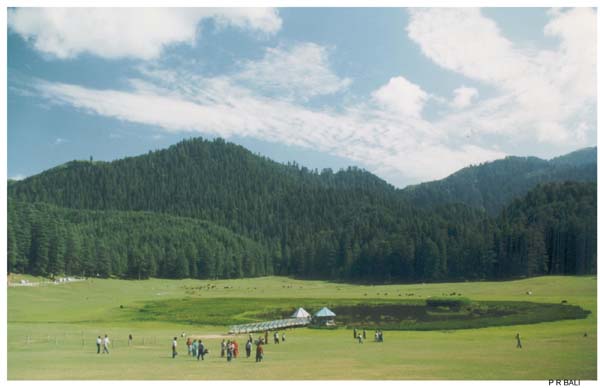
|
|
KHAJJIAR Image by P r
Bali |
It is one of the most scenic
saucer shaped plateau and is surrounded by dense pine and deodar forests.
Its beauty has further been enhanced by a small lake in the centre with a
floating Island and a temple of Khajjiar deity. There is plenty of wild
life in the forest and the area has been brought under Wild Life
Sanctuary, There is a 9 hole Golf ground here but is no more in regular
use. The lake has been taken up for improvement. It is known as the
Gulmarg of Himachal Pradesh. Tourism accommodation is available for
stay.
BHARMOUR(2195m.) It remains the Capital of erstwhile Chamba state during
7th Century and still retains the ruins of old castles & 84 Shivlingam
temples. Situated 64 km away from Chamba, is known as the homeland of
Gaddi( Shepherds) Tribe, who are semi-nomadic and spend the summer on the
Himalayan pastures, grazing their sheep and goats. This place can also be
used as base camp for short trekking routes. A sub division of
Mountaineering and Allied Sports Institute is also working here, which
organizes trekking Mountaineering programme and provides necessary
assistance and guidance to the trekkers and
mountaineers.
KALATOP KHAJJIAR
SANCTUARY:
This
sanctuary area with its well laid out trekking jungle trails both at
Kalatop and Khajjiar is a tourist paradise. Dense Deodar and Fir
forests are places of solitude very close to Dalhousie town. Visitors
should look for pheasants and Serow in these forests but should be
beware of Black bear which can be encountered often in the
area
Chamba
Links
Chamba Information
Resource
|
